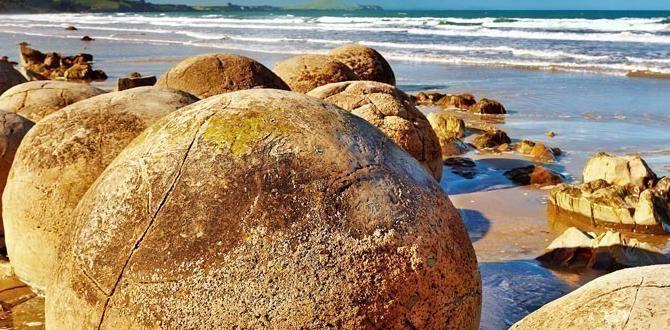Belize Best Time To Visit: The ideal time to visit Belize is during the dry season, from December to May. This period offers sunny days and lower humidity, perfect for exploring beaches, jungles, and ancient Maya sites without the disruption of heavy rains.
Planning a trip to Belize can feel a little overwhelming, especially when you’re trying to figure out the perfect time to go. You want sunshine, comfortable weather, and maybe even fewer crowds, right? It’s easy to get lost in all the information, but don’t worry! We’re here to make it simple and stress-free. We’ll guide you through Belize’s weather patterns, offering clear-cut advice so you can book your dream vacation with confidence. Let’s dive into finding your ideal Belizean adventure!
Understanding Belize’s Climate: Two Main Seasons
Belize enjoys a tropical climate, which essentially boils down to two primary seasons: the dry season and the wet season. Knowing the difference between these two will be your biggest clue in deciding when to visit for the kind of experience you’re looking for.
The Dry Season (December to May)
This is often what people picture when they think of a tropical getaway. The dry season is characterized by plenty of sunshine and lower humidity levels. It’s the prime time for most travelers.
Temperatures: Expect warm days, typically ranging from the mid-70s to the mid-80s Fahrenheit (around 24-30°C).
Rainfall: Minimal. You might encounter a brief, unexpected shower, but long stretches of rain are rare.
Humidity: Lower, making it more comfortable for outdoor activities.
Ideal For: Beach relaxation, snorkeling, diving, exploring Maya ruins, hiking, and island hopping. Many popular activities are at their best during these months.
Crowds: This is peak tourist season, so expect more people and potentially higher prices for flights and accommodations.
The Wet Season (June to November)
Don’t let the name “wet season” scare you off entirely! While this period sees more rainfall, it doesn’t typically mean constant downpours. It can also be a fantastic time to visit, especially if you’re looking for a more budget-friendly trip with fewer tourists.
Temperatures: Still warm, often slightly hotter and more humid than the dry season, ranging from the mid-70s to the high-80s Fahrenheit (around 24-31°C).
Rainfall: More frequent, usually in the form of afternoon thunderstorms. These can be intense but often pass quickly, leaving clear skies. September and October are typically the wettest months.
Humidity: Higher, which can feel muggier.
Ideal For: Exploring lush rainforests, birdwatching, and those seeking a more authentic, less crowded experience. The seas can be a bit rougher, which might affect some diving and snorkeling tours.
Crowds: This is the low season, meaning fewer tourists and often better deals on accommodations and flights.
The “Shoulder” Seasons: Finding a Sweet Spot
If you’re aiming for a balance between great weather and fewer crowds, the shoulder seasons are your best bet. These transitional periods offer a nice compromise.
Late Dry Season (April to May)
As the dry season winds down, April and May offer a great mix. The weather is still excellent, with plenty of sunshine and comfortable temperatures. The crowds start to thin out a bit compared to December through March, and you might snag slightly better deals.
Early Wet Season (June to July)
The beginning of the wet season often starts gently. You’ll experience warm weather with occasional, refreshing afternoon showers. The landscape is incredibly green and vibrant, and the number of tourists decreases noticeably. This can be ideal for those who don’t mind a bit of passing rain in exchange for fewer people and lower costs.
Belize Best Time To Visit Without Crowds
For travelers specifically seeking to visit Belize without crowds, the sweet spot lies in the transitional months.
Late April to May: The tail end of the dry season. You’ll still get great weather, but the peak season rush has subsided.
June to July: The very beginning of the wet season. Expect lush greenery and fewer tourists, with chances of manageable afternoon showers.
November: The buffer month between the wet and dry seasons. Weather typically improves significantly, and the holiday crowds haven’t arrived yet.
These times offer a more relaxed atmosphere, allowing for more personal encounters with the local culture and nature. You might also find that prices for flights and accommodations are more favorable during these periods.
Monthly Breakdown: What to Expect Year-Round
Let’s break down what you can generally expect in Belize month by month. This can help you pinpoint the exact weeks that might work best for your travel style.
January – March: Peak Dry Season & Peak Crowds
Weather: Excellent. Sunny days, low humidity, and very little rain. This is the textbook perfect weather.
Activities: Ideal for all outdoor activities, especially diving and snorkeling the Belize Barrier Reef.
Crowds: Highest. Book well in advance!
Prices: Highest.
April – May: Late Dry / Early Shoulder Season
Weather: Still very good. Warm and sunny, humidity starts to creep up but remains manageable. Rain is still minimal.
Activities: Great for everything. You’ll enjoy the sunshine without the very highest crowds.
Crowds: Decreasing.
Prices: Starting to drop.
June – July: Early Wet Season / Shoulder Season
Weather: Warm and humid. Afternoon showers become more common but are usually brief. The jungle is at its most vibrant and lush.
Activities: Excellent for inland adventures, exploring waterfalls, and enjoying fewer crowds at popular sites. Ocean conditions can be slightly rougher.
Crowds: Significantly fewer.
Prices: Lower.
August – September: Mid-Wet Season
Weather: Hot, humid, and the wettest months. Expect frequent thunderstorms, often in the afternoons. This is also prime hurricane season for the Caribbean.
Activities: Best for those seeking very few tourists and willing to be flexible with plans due to weather. Inland activities are often better than coastal ones.
Crowds: Lowest.
Prices: Lowest.
October – November: Late Wet / Late Shoulder Season
Weather: Transitioning. October can still be wet, but November usually sees a significant decrease in rain and humidity, with beautiful sunny days returning.
Activities: November is fantastic for all activities as the weather improves and before the major holiday rush. October is better for inland exploration.
Crowds: Very few in October, increasing in late November.
Prices: Low for most of October, rising in late November.
December: Start of Peak Season
Weather: Excellent. The dry season begins with pleasant temperatures and sunshine.
Activities: Perfect for all activities.
Crowds: Increasing rapidly, especially after Christmas.
Prices: Rising.
Key Factors to Consider for Your Visit
Beyond just the weather, think about what’s most important for your trip. This helps narrow down the “best time” to your best time.
1. Your Tolerance for Heat and Humidity
If you dislike feeling sticky or sweaty, aim for the drier months (December to May). The lower humidity is a significant comfort factor. If you don’t mind the heat and occasional mugginess, the wet season can still be enjoyable, especially with the cooling effect of a quick shower.
2. Budget Considerations
Traveling during the peak dry season (December to March) means higher costs for flights and accommodation. For budget travelers, the wet season (June to November) offers significant savings. The shoulder seasons (April-May, November) can provide a good balance of reasonable prices and pleasant weather.
3. Crowd Aversion
If you prefer to explore without large groups of people, avoid the peak months of December through March. The shoulder seasons and the heart of the wet season (June to October, excluding major holidays) will offer a more serene experience.
4. Specific Activities You Want to Do
Diving & Snorkeling: The dry season generally offers the best visibility and calmest seas. However, whale shark season (usually March/April and August/September on the southern atolls like Gladden Spit) might dictate your timing.
Jungle Trekking & Caving: The lushness accompanying the wet season can make jungle treks more dramatic and beautiful, though trails might be muddier. Many caves remain accessible year-round.
Birdwatching: Many migratory birds are present during the dry season. However, the vibrant green scenery of the wet season also attracts diverse species.
Fishing: Different seasons are better for different types of fishing. For example, permit fishing can be excellent in the spring.
5. Hurricane Season Preparedness
The Atlantic hurricane season officially runs from June 1st to November 30th. While Belize is rarely hit by major hurricanes, the possibility exists, particularly from August to October. Airlines and hotels have cancellation policies, but it’s wise to monitor weather forecasts if traveling during these months. Travel insurance is highly recommended during this period. The National Hurricane Center provides real-time information and forecasts.
Belize: A Monthly Weather Snapshot for Easy Planning
To help you visualize the year, here’s a table summarizing the typical weather and crowd levels.
| Month(s) | Typical Weather | Humidity | Crowds | Prices | Best For |
|---|---|---|---|---|---|
| December – March | Sunny, warm, pleasant, very little rain | Low | Highest | Highest | Beach, diving, snorkeling, ruins, all activities |
| April – May | Warm, sunny, increasing humidity | Moderate | Moderate to Low | Moderate | Good weather, fewer crowds than peak season |
| June – July | Hot, humid, afternoon showers | High | Low | Low | Lush scenery, inland exploration, budget travel |
| August – October | Hot, very humid, frequent heavy rain, hurricane season | Very High | Lowest | Lowest | Budget travel, flexibility needed, inland focus |
| November | Transitioning; improving weather, less rain | Moderate to High | Low to Moderate | Low to Moderate | Excellent balance of weather and fewer crowds |
Planning for Comfort, Especially with Little Ones (or for Extended Travel)
Whether you’re traveling with young children or are an adult who might need extra comfort and security on longer journeys, planning for convenience is key. Bringing along travel-friendly personal care items can make a world of difference. Items like adult diapers or child-sized diapers can provide peace of mind, ensuring comfort and preventing potential stress during flights, bus rides, or long days of exploration. Packing discreet, absorbent products means you can focus on enjoying the breathtaking scenery and activities Belize has to offer, rather than worrying about logistics. Many modern options are breathable and designed for maximum comfort, so they don’t add bulk or feel cumbersome during warm weather activities.
For families, having child diapers readily available means fewer bathroom breaks needing to be found unexpectedly and less stress when exploring remote Maya sites or during a bumpy boat ride. For adults, having access to reliable personal care items can allow for longer excursions or travel without the constant anxiety of finding facilities. It’s all about removing potential barriers to enjoying your trip to the fullest.
Making the Most of Your Visit
Once you’ve chosen your dates, here are some tips to enhance your Belizean experience:
Book in Advance: Especially if traveling during the dry season (December-March) or over major holidays. Popular accommodations and tours fill up quickly.
Pack Appropriately: Light, breathable clothing is a must. Don’t forget swimwear, sun protection (hat, sunglasses, reef-safe sunscreen), insect repellent, and comfortable walking shoes. For the wet season, a lightweight rain jacket is advisable.
Stay Hydrated: The tropical climate can dehydrate you quickly. Always carry water.
Embrace Flexibility: Especially if traveling during the wet season. Have backup plans in case of unexpected weather.
Consider Travel Insurance: It’s a wise investment, particularly if traveling during hurricane season or for any trip where cancellations or medical emergencies could be costly. Always check the terms and conditions of your policy. You can compare options from providers like TravelInsurance.com to find a plan that suits your needs.
* Learn a Few Spanish or Kriol Phrases: While English is the official language, knowing a few basic phrases in Spanish or Belizean Kriol can be fun and appreciated by locals.
Conclusion
Choosing the best time to visit Belize ultimately depends on your priorities: sunshine, budget, crowds, or specific activities. The dry season from December to May offers the most consistently pleasant weather, perfect for beach lovers and those who prefer lower humidity. If you’re looking to escape the crowds and save money, the wet season from June to November can be a rewarding choice, with lush landscapes and fewer tourists, provided you’re flexible with potential afternoon showers.
For many, the shoulder months of April, May, and November strike an excellent balance, offering good weather without the peak season crowds or prices. No matter when you choose to go, Belize promises a rich tapestry of adventure, culture, and natural beauty. By understanding its climate and considering your personal travel style, you’re well on your way to planning an unforgettable and effortless trip. So pack your bags, book your flights, and get ready to experience the magic of Belize!
Frequently Asked Questions
Q1: Is it safe to visit Belize during hurricane season?
Yes, it is generally safe to visit Belize during hurricane season (June 1st to November 30th). However, it’s important to be aware of the risks and prepared. Monitor weather forecasts closely and consider purchasing travel insurance that covers weather-related cancellations or interruptions. Major tourist areas are well-equipped to handle potential weather events, and authorities issue timely warnings.
Q2: What is the best time to visit Belize for snorkeling and diving?
The best time for snorkeling and diving in Belize is typically during the dry season, from December to May. The seas are calmer, and visibility is excellent. However, if you specifically want to see whale sharks, the months of March, April, August, and September are often recommended for encounters at Gladden Spit.
Q3: Are there mosquitoes in Belize? When are they worst?
Yes, mosquitoes are present in Belize, as in most tropical destinations. They tend to be more prevalent during and immediately after the rainy season (June to November). Using insect repellent, especially during dawn and dusk, is highly recommended. Many accommodations also provide bug screens and fans to help.
Q4: Is Belize expensive to visit?
Belize can cater to various budgets. The peak dry season (December to March) is the most expensive. Traveling during the wet season (June to November) or the shoulder seasons (April-May, November) can significantly lower costs for flights and accommodations. Eating at local eateries (comedores) instead of tourist restaurants also helps save money.
Q5: What is the difference between Belize and other Central American countries regarding travel time?
Belize is a relatively small country, making it easy to get around and see a lot in a shorter time. Travel between popular destinations like the coast, islands, and the Cayo District is often straightforward. This makes it a great choice for those who prefer not to spend too much time in transit. The Belize Tourism Board offers insights into transportation.
Q6: Can I travel to Belize with children? What are the best times for family travel?
Absolutely! Belize is a fantastic family destination. The dry season (December to May) is ideal for families who want consistent sunny weather for beach and outdoor activities. However, the shoulder months (especially April, May, and November) offer a good balance of pleasant weather and fewer crowds, which can make traveling with children more relaxed and budget-friendly.



